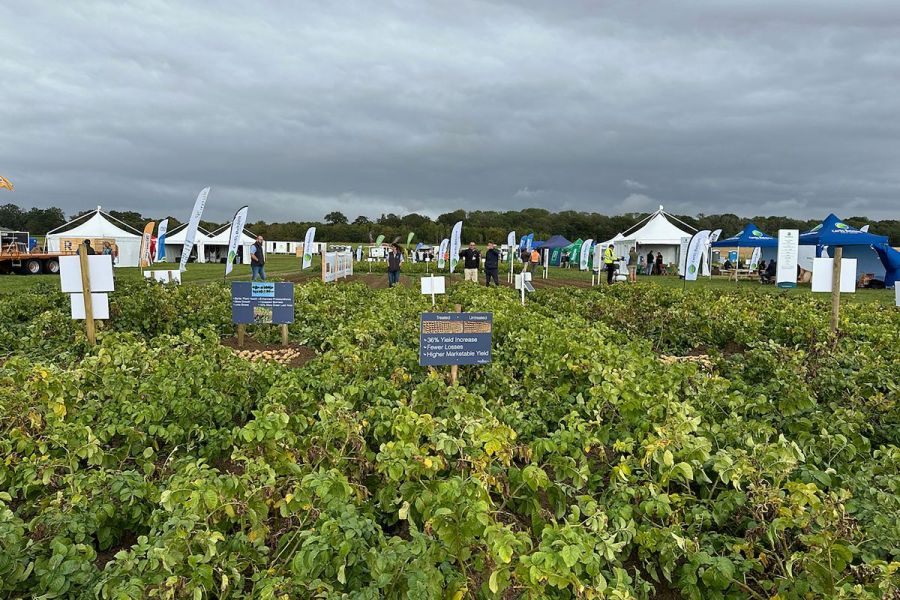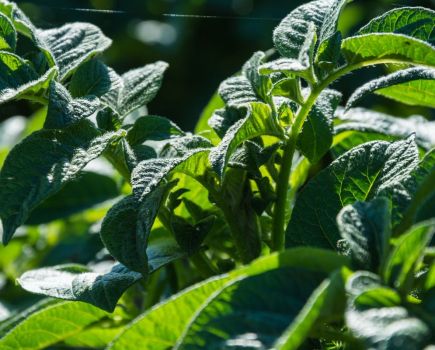Sustainability was the key discussion point at the new Potato Days UK event held at Dyson Farming in Lincolnshire. CPM joined delegates to find out more.
“We can have a good go at making a dent in the carbon footprint number, even if we can’t ultimately get there.”
By Mike Abram
Sustainability – whether debating the question of if net zero is possible, or indeed necessary, within potatoes, or looking for ways of reducing inputs to grow the crop in a more environmentally-friendly way – was the key theme at the new Potato Days UK event hosted recently.
Held at Dyson Farming headquarters on the Nocton Estate and run by Agritechnica organiser DLG, the two-day event was opened by Mark Willcox, agronomy director at Branston. He began by kicking off a panel session which debated whether net zero is possible in potatoes.
“We can have a good go at making a dent in the [carbon footprint] number, even if we can’t ultimately get there,” he suggested, with optimism.
Mark explained that UK agriculture’s percentage of the country’s carbon emissions is increasing due to other industries making progress in reducing their footprints, while agriculture remains flat.
“Our 50M tonnes of emissions now represent about 12% of UK PLC,” he said. “It’s fair to say we haven’t really applied ourselves to the challenge yet, but with retailers thinking about commitments and brands considering what they can claim, that might be the compelling reason for getting the numbers moving.”
Modelling suggests around 100,000t of carbon dioxide equivalent emissions are wrapped up in a 350,000t end-to-end potato supply chain, with growing and storing potatoes accounting for between a quarter and a third of emissions. Transport and haulage of potatoes and packaging are the other ‘big buckets’ when it comes to emissions, added Mark.
Perhaps unsurprisingly, fertiliser, especially nitrogen, accounts for the largest chunk of emissions associated with growing and storing, while cold storage accounts for 18% and farm fuels next on the list.
According to Mark, Branston has already taken steps to reduce its scope-one and -two emissions by doubling its solar capability to provide around 30% of its total energy, and by deducing that finished goods don’t have to be chilled for seven or eight months of the year. Whereas previously, they were chilled all year round, he said. “Which has saved a lot more fuel than you’d think.”
The firm also has a target for a double-digit reduction in mpg for fuel use, which it’s achieving through minor modifications to vehicles and measuring trailer and driver performance.
Mark said investment is also helping. For example, a new mashed potato facility has been installed with an ammonia refrigerant system with zero global warming potential. Then, other plans include using renewable energy guarantees of origin (REGO) sourced electricity, exploring ground source heat pumps as an alternative to heating the last remaining factory which uses fossil fuels, and alternative fuels for trucks.
“Out of our 70 trucks, one of them is electric – I’m not sure about it – while a stepping stone to hydrogen might be biomethane. That could be an option, so we’re trialling one of those too,” said Mark.
He added that an onsite anaerobic digestion plant could potentially supply biomethane if the gas was scrubbed.
On the farming side, progress had been accelerated through involvement in a 3.5-year Innovate UK-funded project with B-Hive, the University of Lincoln, Crop Systems and two potato growers, he said, with six potential mechanisms for reducing emissions identified.
These include low nitrogen varieties, which studies have shown capable of achieving the same marketable yield but using 50% less applied nitrogen. “We now have to work out whether they cook properly and eat consistently,” said Mark.
The second mechanism is using low carbon fertiliser – Branston has been undertaking a six-year trial with a product from CCm Technologies which could cut emissions by 70%, with others also being tested.
Alongside using alternative fuels in tractors, Branston is also measuring the release of greenhouse gases after every type of cultivation on different soil types to understand the impact of cultivations, added Mark.
Whereas a fourth part of the mix could be using in-crop removals which capture carbon dioxide such as applying basalt rock to soils ahead of potatoes or other crops. Another example of potential in-crop removal is photocatalytic foliar applications which react with sunlight and convert passing nitrous oxide molecules into harmless nitrogen and oxygen gases.
Reducing the energy required for long-term potato storage by more than 50% is another target the project is investigating, comparing a low energy store with an existing one. “Around 30% would be achieved by new innovation, with the remaining 20% from solar panels which should be standard on stores if affordable,” suggested Mark.
Finally, opportunities through the Precision Breeding Act to develop varieties which cut waste, for example, by reducing bruising, could prove a quick way to reduce carbon footprints, he said.
These potential changes and innovations are behind Mark’s optimism regarding whether net zero could be possible. “Currently, a potato crop emits about 82kgCO2e/t packed, and just using low carbon fertiliser will reduce that by 30kgCO2e/t, new fuels another 4.5t and if the low energy cold store works, which we will know in around eight months’ time, 7.5tCO2e/t.
“That takes us halfway without doing anything like banning destoning, only using hydrogen-powered tractors, going organic or using very low nitrogen rates – a recipe for low yields and growers bailing out of potatoes.
“Whereas the project has identified practical steps that will get us halfway there. It’ll cost a premium, albeit relatively small though,” he noted.
During the following debate, Dan Cross, managing director of Dyson Farming, stressed that understanding who values reaching net zero is crucial. “Are we trying to achieve targets driven by supermarkets or the government, or is there a genuine belief in the population that net zero potatoes or food is beneficial?
“At what point are you willing to pay a premium of 10-20%? In the short-term at least, there’s a cost to making transitions even when making the logical, sensible ones Mark is suggesting.”
Crop-based targets are potentially meaningless in comparison with whole-farm calculations and could create future risks for the industry, he added, suggesting they could be used to drive down production of root crops in the UK if targets weren’t achieved.
“The likelihood of our national diet changing significantly to not consume root crops is pretty slim, which would mean we’d just offshore some carbon emissions. So I slightly disagree with Mark’s optimism. We have to be hopeful and positive and take action, but also be realistic in what we suggest is possible,” he concluded.
This article was taken from the latest issue of CPM. Read the article in full here.
For more articles like this, subscribe here.
Sign up for Crop Production Magazine’s FREE e-newsletter here.




